Robson Street, a major arterial in downtown Vancouver, BC, can be two very different places. On a Saturday in late summer, I found an entire block of Robson closed to cars and filled with people, some lounging on wooden benches under big yellow umbrellas. Amazing smells wafted from nearby food trucks, and a crowd gathered to watch an artist create a replica of the Mona Lisa on the pavement. The following Monday, the block had reverted to its typical configuration, with car traffic on the roadway and pedestrians crowding the sidewalks. I could make out only a hint of the artwork painted on the asphalt just two days earlier.
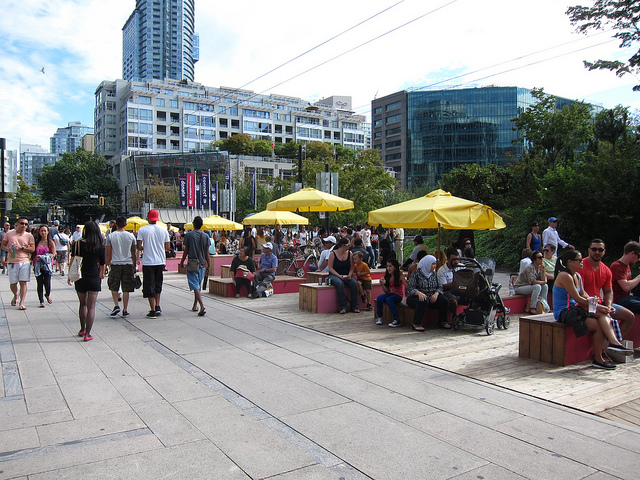
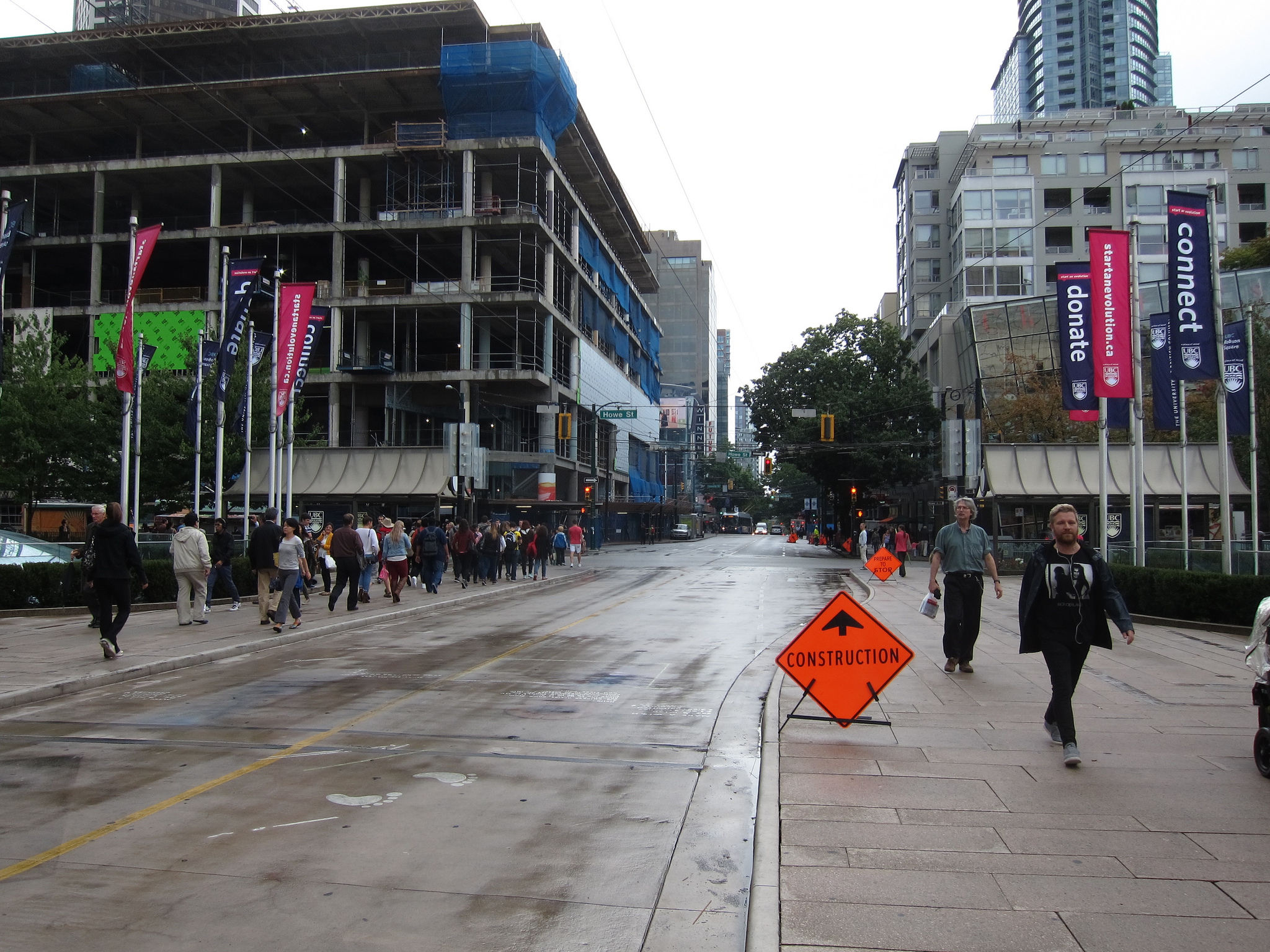
The temporary Robson Square my family and I had enjoyed with many others that sunny Saturday came about through a city initiative called VIVA Vancouver, whose mission is to activate streets as public spaces. VIVA Vancouver commenced in 2011 to help Vancouver businesses, residents, and community groups turn parking spaces into mini-parks, pavement into temporary plazas, and streets into marketplaces and festival grounds.
In contrast to the slow, process-heavy pace of most civic projects, VIVA is action-oriented: it embraces the “Lighter, Quicker, Cheaper” development strategy that views streets as places for experimenting with temporary installations and pilot projects. The smaller, lower-cost projects reduce stress on city staffers to find the perfect solution and make it less risky to try new ideas.
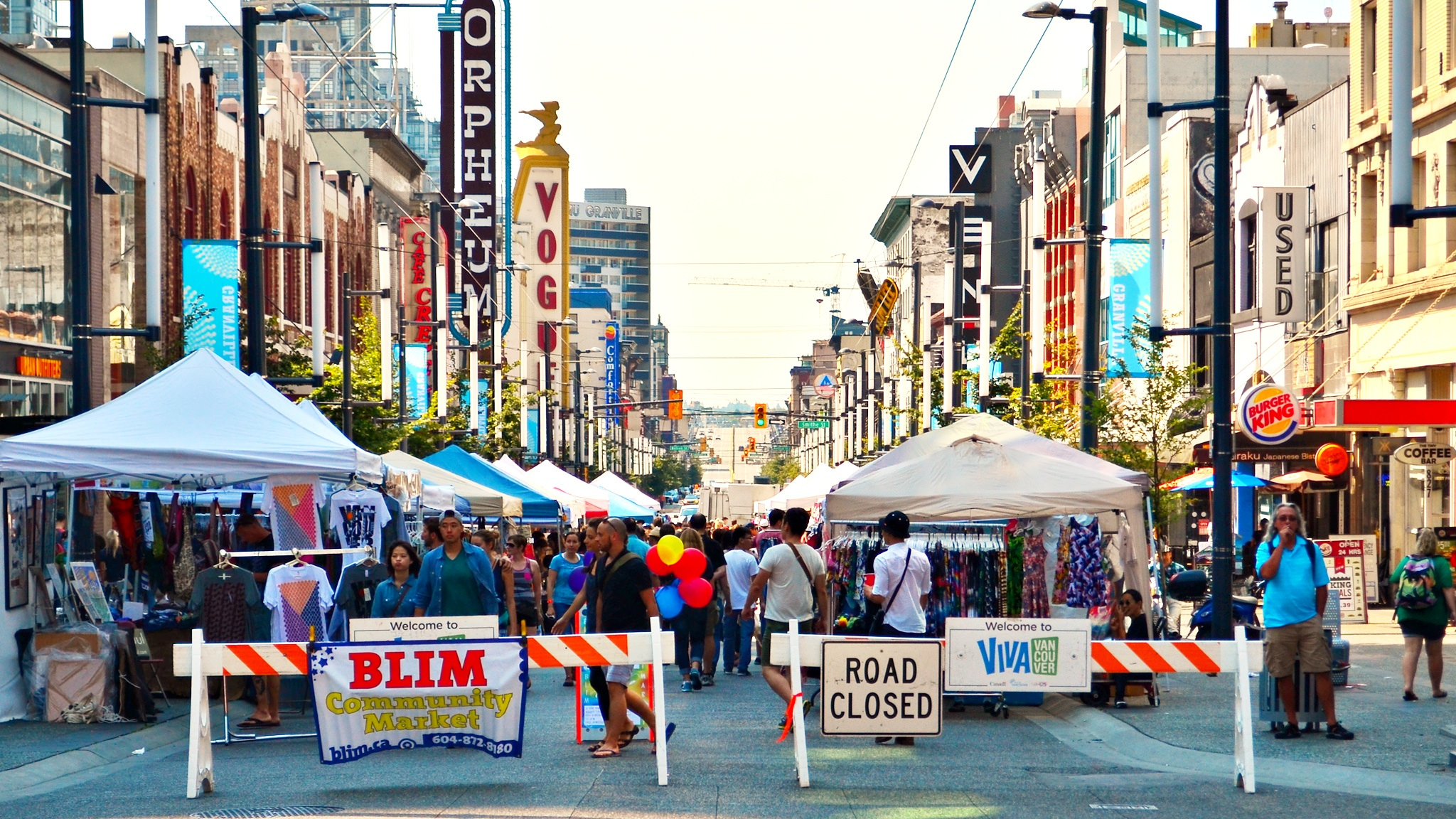
Streets are a unique laboratory for experimentation because they account for more public space than parks, typically comprising 20 to 30 percent of publicly owned land in cities. Giving more of the road back to people allows cities to add open space more cheaply and easily than by adding parks.
Let’s take a look at some of the VIVA Vancouver projects.
Robson Square
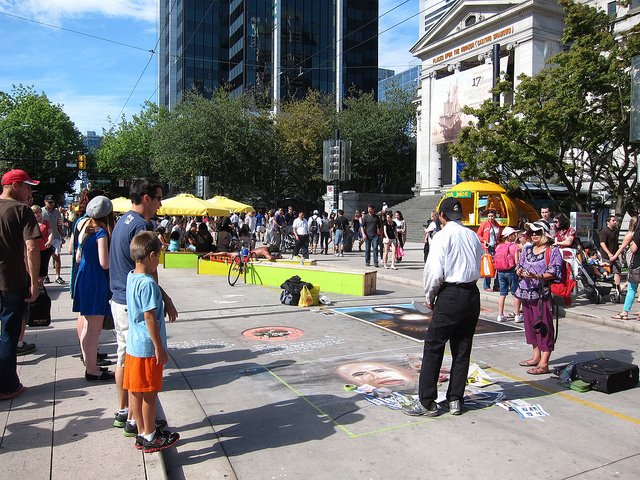
During the 2010 Winter Olympics, the 800 block of Robson Street (known as Block 51) became a pedestrian plaza where people gathered for activities related to the Games—no ticket required.
After the Olympics, Vancouver residents were vocal about keeping the public plaza. An advocacy organization called Vancouver Public Space Network (VPSN) created two petitions in 2011: one to permanently close that block of Robson to vehicles and one to keep it open to traffic. VPSN collected 1,900 signatures on the public plaza petition and only 42 on the petition to keep the block open to cars. Hundreds of people attended community meetings on the issue, and more than 2,000 completed a survey about it in 2012—making it the city’s most popular online survey ever.
The city government wasn’t ready for a permanent closure, however. VIVA offered a way to keep trying out ideas without making a permanent decision. Each year, VIVA solicits design ideas from Vancouver and around the world for the upcoming summertime conversion of Robson. A jury of Vancouver designers and architects reviews the proposals, and the design they select is constructed and remains open 24 hours a day between Canada Day (July 1) and Labor Day weekend in early September.
During the closure, VIVA keeps tabs on Block 51 activity through pedestrian counts, behavior mapping, video footage, and user surveys. The information can help inform decision makers when they consider a permanent closure.
Robson Square became an Urban Reef in the summer of 2014. A long wooden structure included spaces where people could stand and eat a snack, lay down and read a book, or sit and chat with a friend.
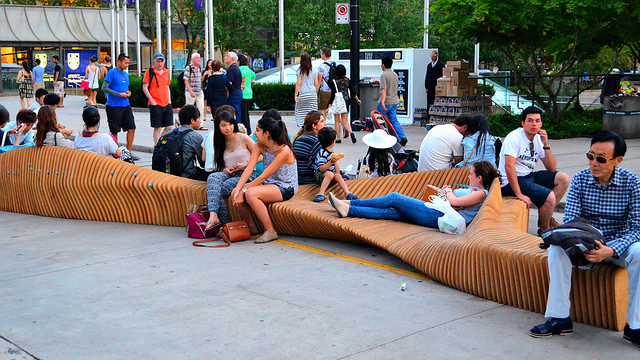
The plaza stays busy throughout the day, as shown in this YouTube time-lapse video:
Granville Summer Series
The Granville Summer Series activates another downtown street, Granville Street, on summer weekends. Local businesses, community groups, and cultural organizations all get involved, and the result is an ever-changing lineup of fun events and performances, from dancing lessons, hula hooping, and concerts to arts-and-crafts markets and an Indian block party complete with Bollywood makeovers. The street closure creates about 29 acres of temporary open space.
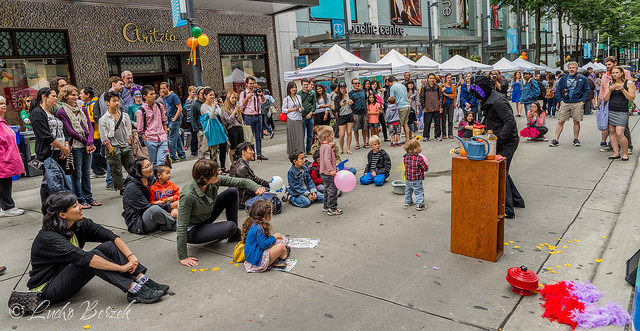
I visited Granville during TaiwanFest, which closed out the 2013 summer series. My family and I strolled along the street enjoying the smells from food stalls, watching kids play games, and slowing to listen to lectures about health and wellness. A little girl stepped on stage at a karaoke booth and belted out a favorite tune, with the crowd cheering her as she finished.
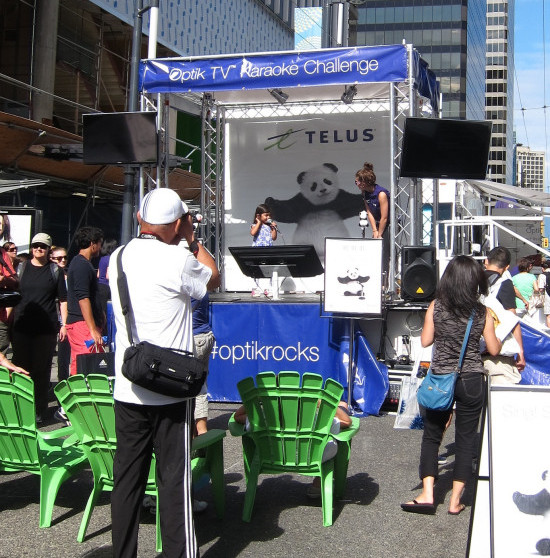
In July, Granville is transformed into a Latin American carnival by a local organization called LatinCouver. During Carnaval del Sol, the street is like a Latin American town plaza, with musicians and dancers entertaining the crowd while vendors sell Latin American wares. Children and adults participate in street soccer tournaments.

The Vancouver Buskerfest brings world-class buskers to Granville Street to entertain with their stunts and shows—often involving crowd participation.
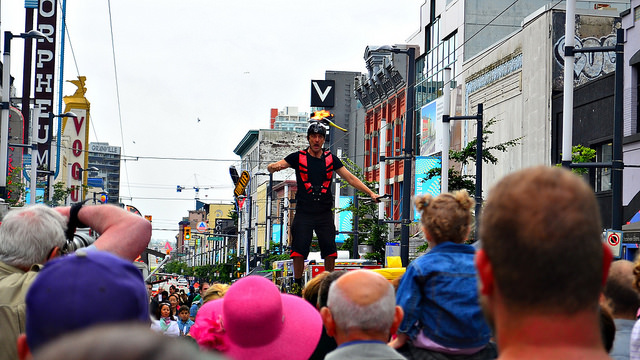
The Vancouver Swing Society turns Granville Street into a dance floor where everyone is encouraged to join in.
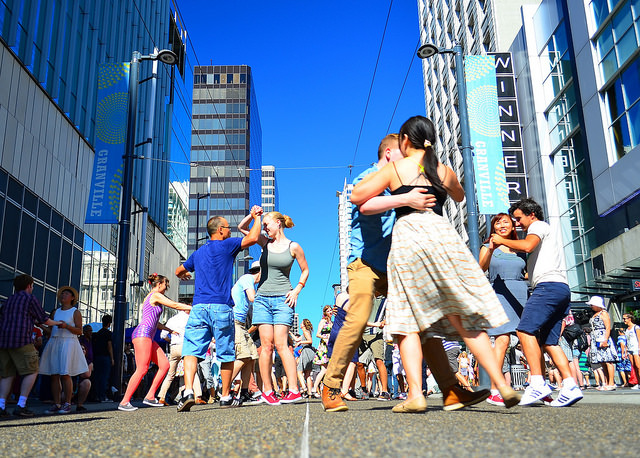
Vancouver Parklets
Summertime events and installations are only part of what VIVA brings to Vancouver’s streets. It also seeks out supportive business and community groups to build curbside parklets. The early parklets include the much-loved Parallel Park in East Vancouver’s Mount Pleasant neighborhood, which I wrote about here in 2013. When I visited the parklet on a sunny September afternoon, I found it bustling with coffee-drinkers, newspaper-readers, and people-watchers.
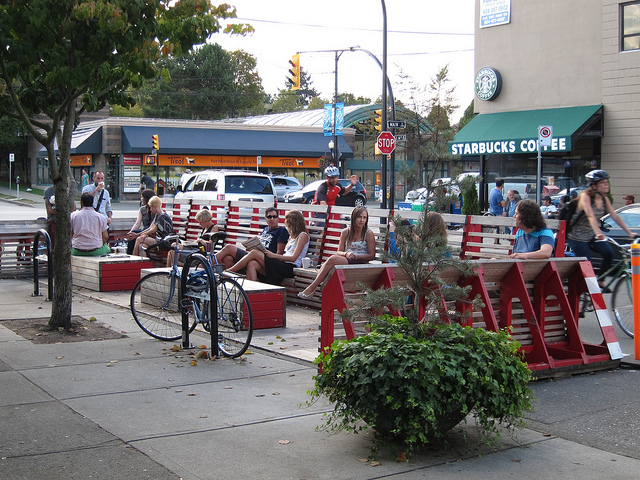
The French Quarter parklet replaced two parking stalls in the Riley Park neighborhood in the summer of 2014. A local shop owner joined forces with a landscape architecture intern to create it, and community members are raising money through a Kickstarter campaign to pay for amenities including umbrellas and a bike bar that lets cyclists stop and enjoy the parklet while still sitting on their bikes.
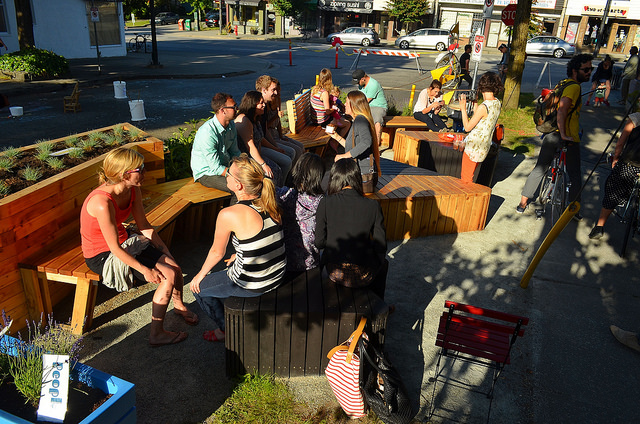
The Heart of Davie Village Plaza
The Heart of Davie Village Plaza, at the intersection of Davie and Bute streets in Vancouver’s West End, originated when community members joined forces during the 2012 Vancouver Pride festivities to paint Bute Street during a temporary closure. This sparked interest in a permanent plaza among city staff, neighbors, and community groups.
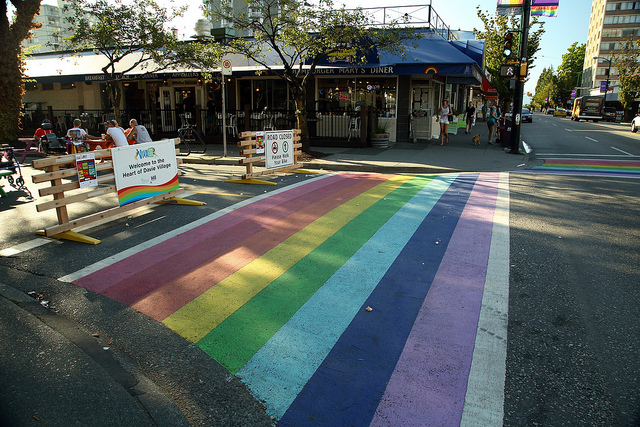
A year later, VIVA painted rainbow crosswalks at the intersection to kick off a longer pilot closure, and the Heart of Davie Village Plaza was born. Community members joined VIVA staff to paint picnic tables for the plaza, which was open in time for the 35th anniversary of Vancouver Pride in July 2013.
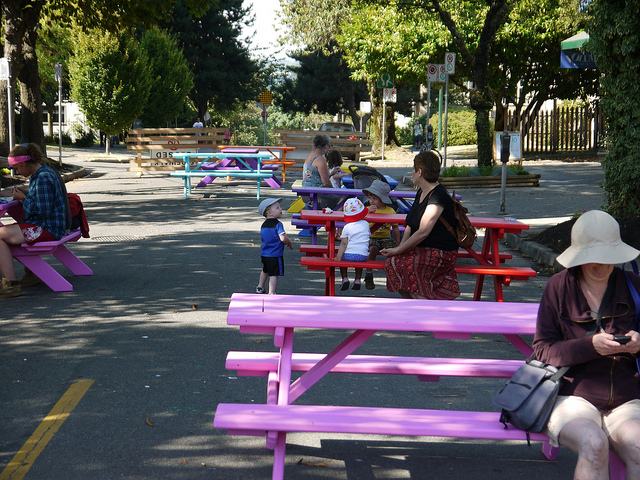
VIVA held several events to activate the space and gauge community response. Over hot chocolate, live music, and games, VIVA staff solicited feedback through conversations, direct observation, and a chalkboard where visitors could respond to the phrase “Our Bute Street Is”. The pilot closure ended in September 2014, but feedback from the community supports creating a permanent plaza.
By starting with quick, low-cost projects, VIVA is helping to enliven Vancouver’s streets and encourage neighbors to try out new ideas. The Lighter, Quicker, Cheaper approach helps Vancouver tap the community’s creativity and talent and inspire residents, business owners, and city leaders to see streets not just as places to move through but also spaces to just be.

